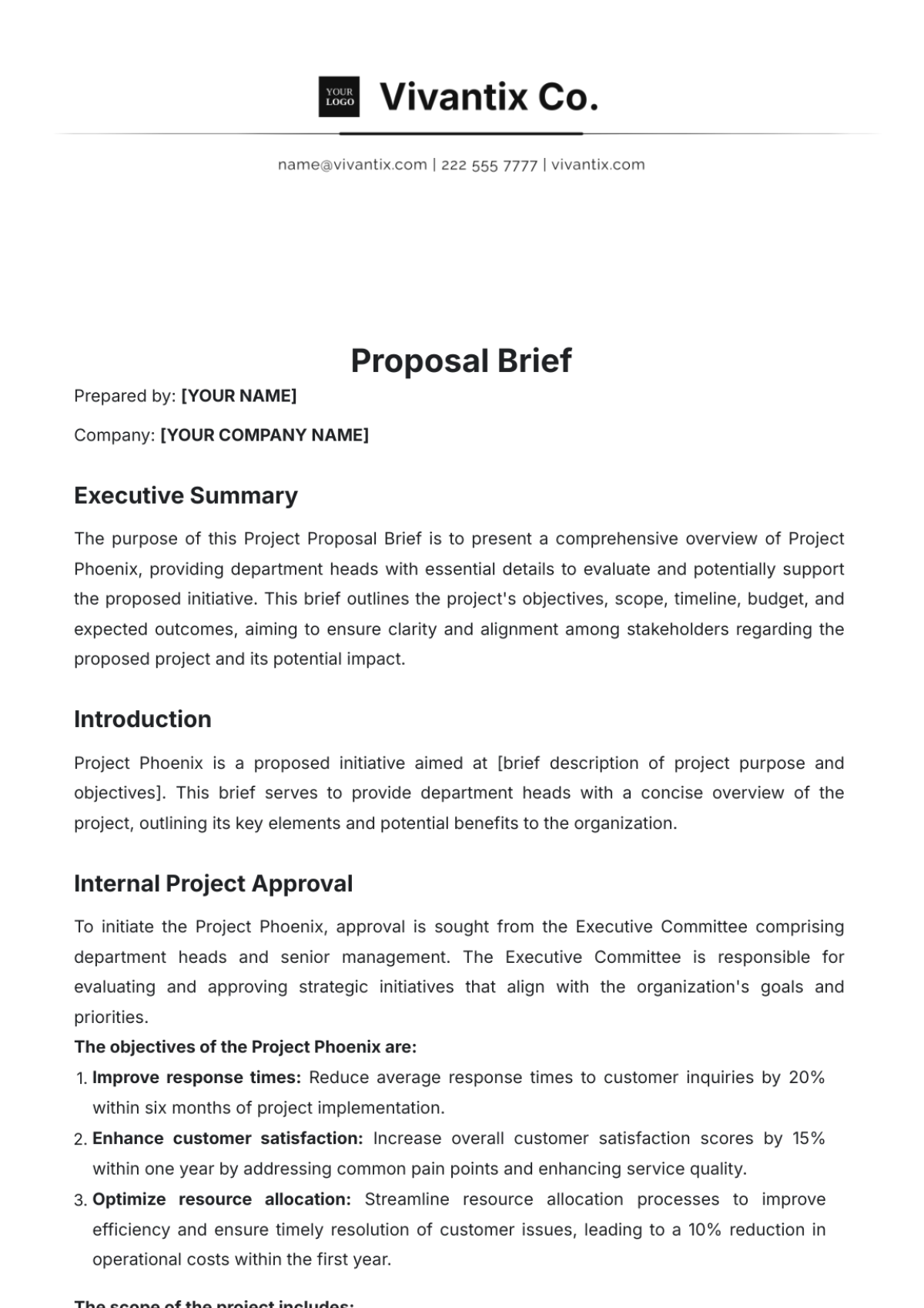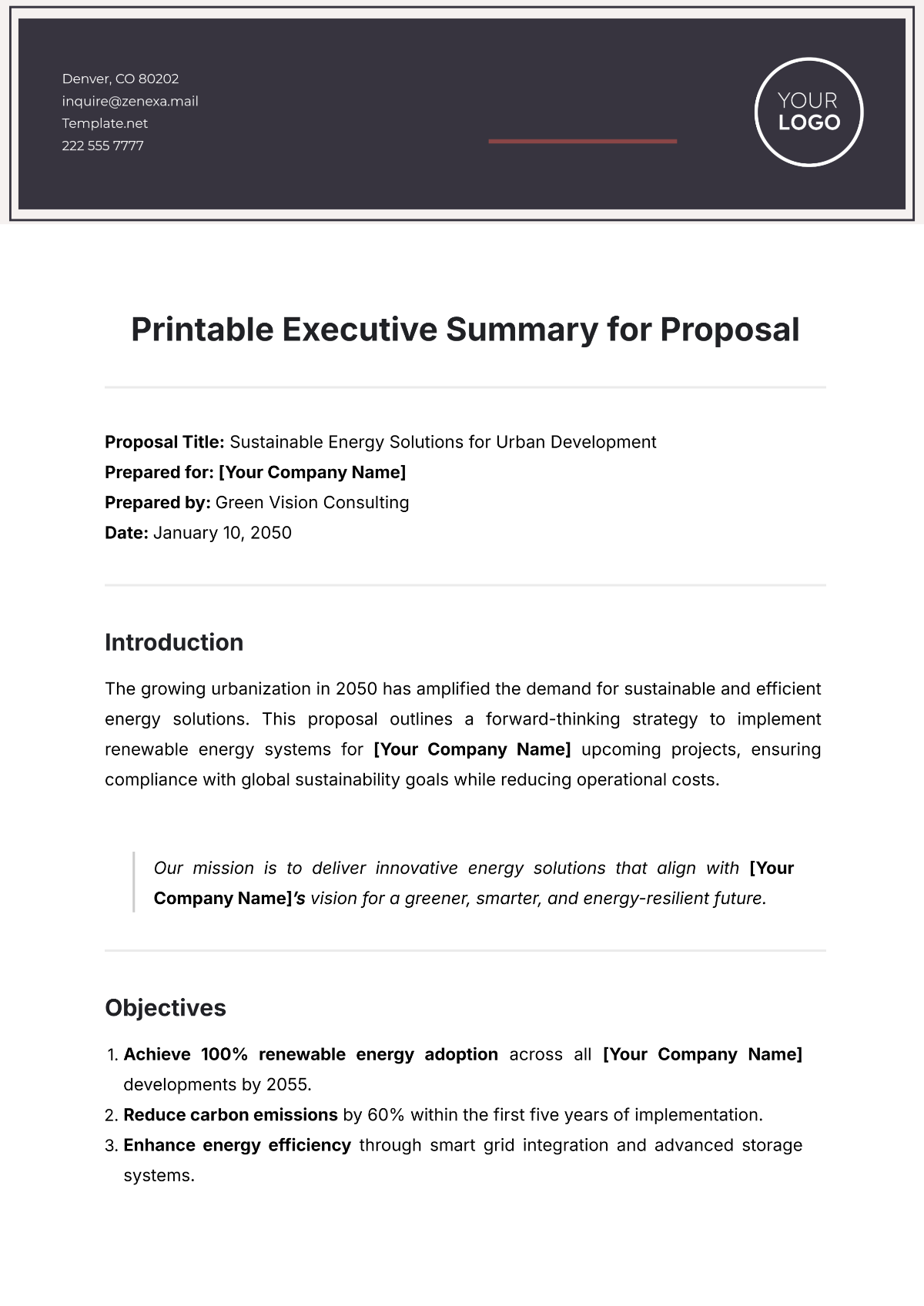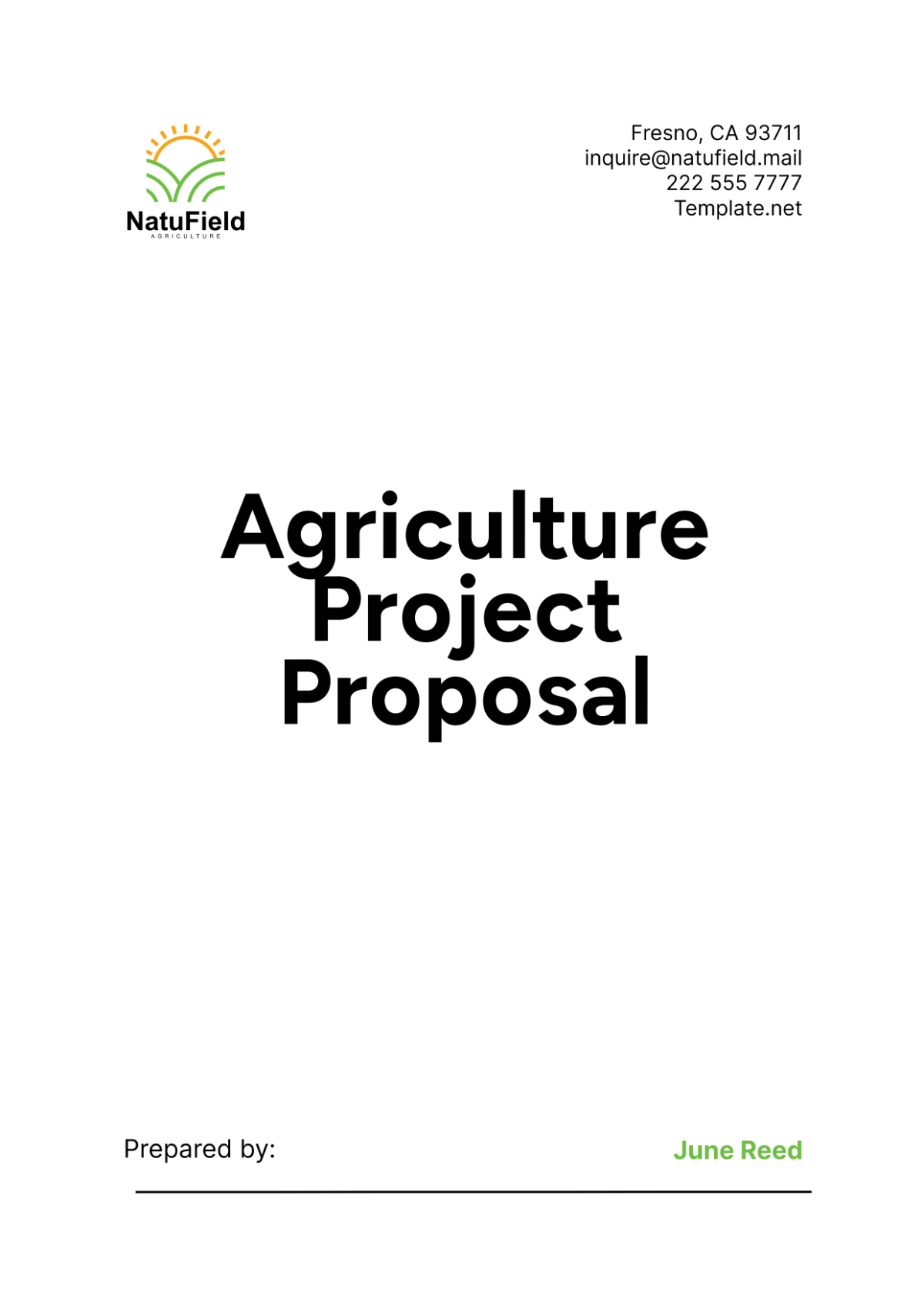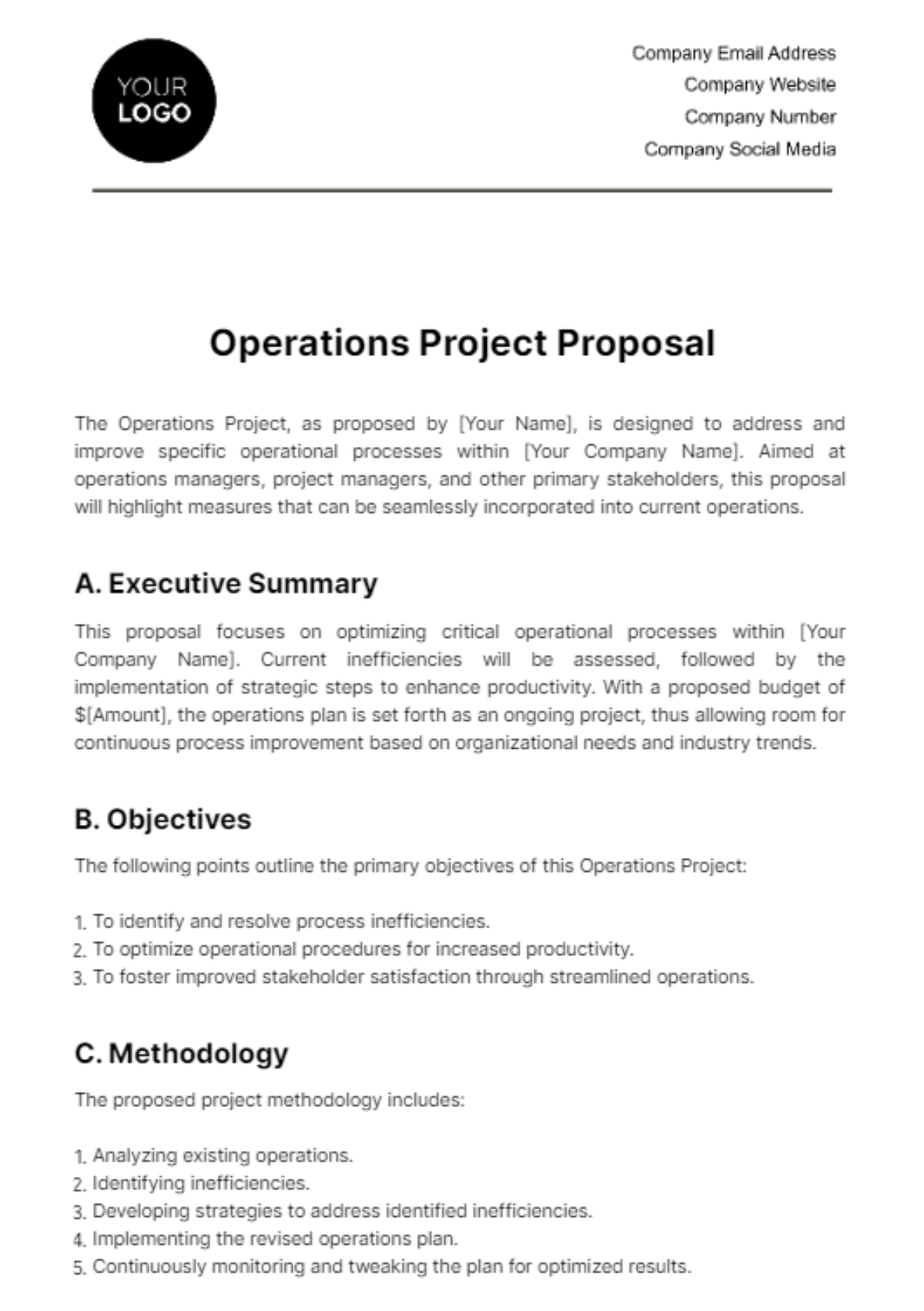Agriculture Project Proposal
I. Executive Summary
A. Project Overview
The "Sustainable Agriculture Initiative" by [Your Company Name] is a comprehensive program designed to revolutionize agricultural practices across [region]. Our initiative focuses on leveraging cutting-edge technologies and sustainable farming methods to address key challenges faced by farmers today. By promoting efficient resource management, enhancing soil health, and integrating smart farming technologies, we aim to significantly boost agricultural productivity while minimizing environmental impact.
B. Objectives
Increase agricultural productivity by 30% over the next five years through the adoption of modern farming techniques and technologies.
Implement sustainable farming practices on 10,000 hectares of farmland to improve soil health, reduce chemical inputs, and enhance biodiversity.
Reduce water usage by 20% through the implementation of precision irrigation systems and water management strategies tailored to local conditions.
Improve soil health and fertility by promoting organic farming practices, crop rotation, and the use of compost and biofertilizers.
Integrate smart farming technologies such as IoT-enabled sensors, drones, and farm management software to monitor crop health, optimize resource use, and improve decision-making for farmers.
C. Expected Outcomes
The initiative aims to achieve the following outcomes:
Enhanced Crop Yields and Quality: By implementing sustainable practices and utilizing advanced technologies, farmers can expect higher yields and improved quality of produce, thereby increasing their profitability.
Improved Farmer Incomes and Livelihoods: By reducing input costs, enhancing productivity, and accessing premium markets through certification of sustainable practices, farmers' incomes and livelihoods will be strengthened.
Reduced Environmental Impact: Through reduced chemical usage, improved water management, and enhanced soil health, the initiative will contribute to biodiversity conservation and mitigate climate change impacts.
Increased Adoption of Smart Farming Technologies: By demonstrating the benefits of smart technologies and providing training and support, we aim to increase the adoption rate among farmers, leading to more efficient farm operations.
Strengthened Agricultural Value Chains: By integrating farmers into sustainable supply chains and facilitating market linkages, the initiative will enhance market access and resilience to market fluctuations.
II. Project Background
A. Current Agricultural Challenges
The agricultural sector in [region] faces several challenges that hinder its sustainability and productivity:
Outdated Farming Techniques: Many farmers still rely on traditional farming methods that are inefficient and labor-intensive, leading to stagnated productivity.
Depletion of Soil Nutrients: Continuous use of chemical fertilizers has depleted soil fertility, affecting long-term agricultural productivity.
Water Scarcity: Erratic rainfall patterns and inefficient irrigation systems contribute to water scarcity, impacting crop yields and farmer livelihoods.
Dependency on Chemical Inputs: Excessive use of chemical fertilizers and pesticides poses environmental risks and health hazards while increasing production costs.
Limited Access to Technologies: Smallholder farmers lack access to modern farming technologies, limiting their ability to adopt more efficient and sustainable practices.
B. Importance of Sustainable Agriculture
Sustainable agriculture is crucial for [region/country]'s future food security, environmental sustainability, and economic development. It encompasses practices that maintain soil health, conserve water resources, reduce greenhouse gas emissions, and promote biodiversity. By transitioning towards sustainable agriculture, we can build resilience against climate change, enhance food production efficiency, and improve farmers' livelihoods.
III. Project Description
A. Project Phases
Phase 1: Planning and Assessment
Conduct comprehensive baseline surveys and assessments to understand current farming practices, soil conditions, water availability, and technological readiness among farmers.
Engage with local agricultural stakeholders, including farmers, cooperatives, and governmental agencies, to build partnerships and ensure community buy-in.
Develop a detailed project plan that outlines specific objectives, activities, timelines, and budgetary requirements.
Phase 2: Implementation
Roll out training programs and capacity-building workshops to educate farmers on sustainable agricultural practices, soil management techniques, water conservation methods, and the use of smart farming technologies.
Distribute organic fertilizers, biopesticides, and other inputs to encourage the adoption of organic farming practices and reduce reliance on chemical inputs.
Install and calibrate precision irrigation systems, weather stations, and soil moisture sensors to optimize water use efficiency and improve crop yield predictions.
Facilitate access to farm management software and mobile applications that enable farmers to monitor crop health, pest outbreaks, weather forecasts, and market prices in real-time.
Phase 3: Monitoring and Evaluation
Establish a robust monitoring and evaluation framework to track the progress and impact of project activities on agricultural productivity, soil health, water use efficiency, and adoption of sustainable practices.
Conduct regular field visits, surveys, and focus group discussions with participating farmers to gather qualitative and quantitative data on project outcomes and challenges.
Analyze data collected from remote sensing technologies, satellite imagery, and GIS mapping to assess changes in land use, crop health, and environmental conditions over time.
Engage independent evaluators and agricultural experts to review project performance, identify lessons learned, and recommend adjustments to project strategies as needed.
Phase 4: Expansion and Scaling
Scale up successful interventions and best practices to additional regions and communities, leveraging lessons learned and stakeholder feedback from initial project phases.
Strengthen institutional partnerships with research institutions, universities, private sector entities, and government agencies to promote knowledge sharing, innovation, and policy advocacy for sustainable agriculture.
Secure additional funding and resources through grants, partnerships, and corporate sponsorships to sustain and expand project activities beyond the initial implementation period.
B. Key Activities
Training and Capacity Building
Organize farmer field schools, demonstration plots, and experiential learning sessions to build practical skills and knowledge on sustainable farming practices.
Provide training on the proper use and maintenance of smart farming technologies, including drone-assisted crop monitoring, automated irrigation systems, and digital farm management tools.
Foster peer-to-peer learning and knowledge exchange among farmers through farmer-to-farmer extension services and community-based organizations.
Technology Integration
Deploy Internet of Things (IoT) devices, such as soil sensors, climate monitors, and automated weather stations, to collect real-time data on soil moisture levels, temperature variations, and rainfall patterns.
Utilize remote sensing technologies, including satellite imagery and drones, to assess crop health, detect pest infestations, and monitor changes in land cover and vegetation indices.
Implement cloud-based farm management software and mobile applications that enable farmers to access personalized agronomic advice, weather forecasts, market information, and digital financial services.
Resource Management
Promote integrated pest management (IPM) strategies, biological pest control agents, and crop rotation techniques to reduce pest outbreaks and enhance soil biodiversity.
Introduce cover cropping, mulching, and composting practices to improve soil structure, fertility, and water retention capacities, thereby reducing the need for synthetic fertilizers and enhancing carbon sequestration.
Install energy-efficient irrigation systems, such as drip irrigation and micro-sprinklers, to minimize water wastage, optimize nutrient delivery, and enhance crop water use efficiency under varying climatic conditions.
IV. Implementation Plan
A. Timeline
Phase | Duration | Start Date | End Date |
|---|---|---|---|
Planning and Assessment | 6 months | Jan 2050 | Jun 2050 |
Implementation | 2 years | Jul 2050 | Jun 2052 |
Monitoring and Evaluation | 1 year | Jul 2052 | Jun 2053 |
Expansion and Scaling | Ongoing | Jul 2053 | Dec 2055 |
B. Budget
Item | Cost (USD) |
|---|---|
Training and Workshops | $200,000 |
Smart Farming Technologies | $500,000 |
Organic Fertilizers and Inputs | $300,000 |
Irrigation Systems | $400,000 |
Monitoring and Evaluation | $150,000 |
Administrative Costs | $100,000 |
Contingency Fund | $50,000 |
Total | $1,700,000 |
V. Stakeholder Analysis
A. Key Stakeholders
Farmers
Primary beneficiaries of the project who will receive training, technical support, and access to resources to adopt sustainable farming practices.
Active participants in decision-making processes, project planning, and implementation activities.
Local Agricultural Organizations
Strategic partners in project implementation who provide technical expertise, extension services, and institutional support to farmers.
Facilitators of farmer cooperatives, producer organizations, and community-based initiatives for collective action and knowledge sharing.
Government Agencies
Policy makers and regulatory bodies responsible for creating an enabling environment through agricultural policies, incentives, and supportive frameworks.
Providers of financial resources, infrastructure development, and market access opportunities for smallholder farmers and rural communities.
Technology Providers
Suppliers of smart farming technologies, digital solutions, and innovation hubs that offer scalable, affordable, and user-friendly tools for precision agriculture.
Collaborators in research and development partnerships to customize technology solutions and address specific challenges faced by farmers.
Financial Institutions
Providers of financial services, credit facilities, and microfinance options tailored to the needs of smallholder farmers and agricultural enterprises.
Investors in sustainable agriculture initiatives, impact-driven projects, and market-driven solutions that promote economic growth and rural development.
VI. Risk Management
A. Potential Risks
Resistance to Change
Farmers may exhibit initial reluctance to adopt new practices and technologies due to unfamiliarity, perceived risks, or cultural preferences.
Mitigation: Conduct participatory demonstrations, farmer field schools, and learning exchanges to build trust, demonstrate tangible benefits, and address misconceptions through peer-to-peer learning networks.
Weather Variability
Unpredictable climate patterns, extreme weather events, and seasonal fluctuations in rainfall may adversely affect crop production and yield outcomes.
Mitigation: Implement climate-smart agriculture practices, drought-resistant crop varieties, water-saving irrigation technologies, and contingency planning measures to build resilience against climate risks and enhance adaptive capacity.
Resource Constraints
Limited availability of organic inputs, renewable energy sources, and technological infrastructure may hinder the widespread adoption and scalability of sustainable agriculture practices.
Mitigation: Forge strategic partnerships with local suppliers, distributors, and research institutions to strengthen supply chains, facilitate knowledge transfer, and leverage economies of scale for cost-effective procurement and distribution of inputs.
Market Fluctuations
Volatility in agricultural commodity prices, supply chain disruptions, and fluctuating market demands may impact farmer incomes, profitability, and long-term sustainability.
Mitigation: Foster market linkages, value chain integration, and contract farming agreements to provide farmers with stable market access, fair pricing mechanisms, and market intelligence tools to make informed decisions and reduce market risks.
VII. Monitoring and Evaluation
A. Performance Indicators
Agricultural Productivity
Measure the increase in crop yields, quality standards, and production volumes per hectare across participating farms.
Target: Achieve a 30% improvement in crop yields and profitability through enhanced agronomic practices, precision farming technologies, and sustainable land management strategies.
Soil Health
Assess changes in soil fertility, nutrient content, organic matter levels, and soil structure improvements resulting from the adoption of organic farming methods and regenerative agriculture practices.
Target: Enhance soil health indicators by promoting soil conservation practices, biodiversity conservation, and carbon sequestration efforts to mitigate climate change impacts and improve ecosystem resilience.
Water Usage
Monitor reductions in water consumption rates, irrigation efficiency gains, and water-saving measures adopted by farmers to optimize water resources and minimize environmental impacts.
Target: Achieve a 20% reduction in water usage through the adoption of precision irrigation technologies, water-efficient crop varieties, and rainwater harvesting systems to enhance water productivity and ensure sustainable water management practices.
Technology Adoption
Track the adoption rates of smart farming technologies, digital innovations, and data-driven decision-making tools among participating farmers.
Target: Increase the adoption rate of smart farming technologies to 70% among smallholder farmers, agribusiness enterprises, and rural communities to enhance productivity, profitability, and resilience to climate change.
B. Data Collection Methods
Surveys and Interviews
Conduct baseline surveys, mid-term assessments, and end-line evaluations to gather qualitative and quantitative data on farmer perceptions, knowledge gaps, and behavior change outcomes related to sustainable agriculture practices.
Utilize participatory rural appraisal (PRA) techniques, focus group discussions (FGDs), and key informant interviews to capture stakeholders' perspectives, community feedback, and local insights into project impacts and challenges.
Remote Sensing and GIS
Deploy satellite imagery, geographic information systems (GIS), and drone technology to monitor land use changes, vegetation dynamics, and spatial patterns in crop growth, yield potential, and soil moisture content.
Utilize spatial data analysis, satellite remote sensing, and digital mapping tools to assess environmental impacts, landscape changes, and ecosystem services provided by agroecosystems under different management practices.
Field Visits and Inspections
Conduct regular field visits, farm assessments, and technical inspections to verify compliance with sustainable agriculture standards, monitor on-ground implementation, and ensure quality control of project interventions.
Conduct agronomic trials, field experiments, and pilot demonstrations to test new technologies, evaluate crop performance, and validate research findings to support evidence-based decision-making and adaptive management practices.
VIII. Sustainability Plan
A. Long-term Strategy
Capacity Building
Institutionalize farmer training programs, capacity-building workshops, and educational campaigns to promote lifelong learning, skills development, and knowledge transfer on sustainable agriculture practices.
Establish community-based learning centers, demonstration farms, and farmer field schools as hubs for experiential learning, innovation diffusion, and adaptive management practices to foster continuous improvement and technology adoption among smallholder farmers and rural communities.
Institutional Partnerships
Strengthen collaborative partnerships with local agricultural research institutions, universities, extension services, and non-governmental organizations (NGOs) to promote research and development (R&D), technology transfer, and innovation diffusion in sustainable agriculture.
Facilitate knowledge exchange, capacity building, and mentorship programs for young farmers, women entrepreneurs, and rural youth to promote inclusive agricultural growth, gender equity, and social inclusion in rural development initiatives.
Policy Advocacy
Advocate for supportive policies, regulatory reforms, and incentive mechanisms that promote sustainable agriculture, climate-smart farming practices, and resilient agroecosystems in national development agendas.
Engage policymakers, government agencies, and stakeholders in policy dialogues, multi-stakeholder platforms, and advocacy campaigns to integrate sustainable agriculture priorities into agricultural policies, rural development strategies, and climate change adaptation plans at local, national, and regional levels.
IX. Conclusion
The "Sustainable Agriculture Initiative" by [Your Company Name] is poised to catalyze a transformative shift in agricultural development, resilience, and sustainability across [region]. By harnessing the power of innovation, technology, and community engagement, we can build a future where agriculture thrives in harmony with nature, ensuring food security, economic prosperity, and environmental stewardship for generations to come. With a strategic focus on capacity building, technology adoption, and policy advocacy, this initiative aims to empower farmers, strengthen rural livelihoods, and pave the way for a more sustainable and resilient agricultural sector.
















































